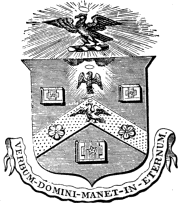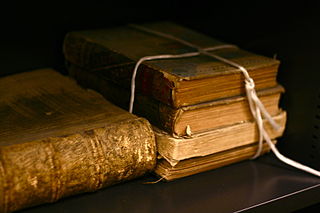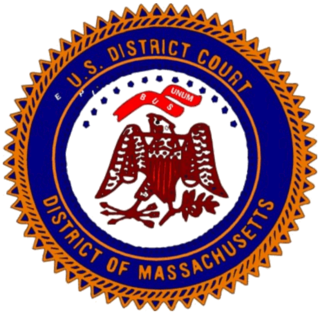Related Research Articles
A copyright is a type of intellectual property that gives its owner the exclusive right to copy, distribute, adapt, display, and perform a creative work, usually for a limited time. The creative work may be in a literary, artistic, educational, or musical form. Copyright is intended to protect the original expression of an idea in the form of a creative work, but not the idea itself. A copyright is subject to limitations based on public interest considerations, such as the fair use doctrine in the United States.

Intellectual property (IP) is a category of property that includes intangible creations of the human intellect. There are many types of intellectual property, and some countries recognize more than others. The best-known types are patents, copyrights, trademarks, and trade secrets. The modern concept of intellectual property developed in England in the 17th and 18th centuries. The term "intellectual property" began to be used in the 19th century, though it was not until the late 20th century that intellectual property became commonplace in most of the world's legal systems.

The Statute of Anne, also known as the Copyright Act 1709 or the Copyright Act 1710, was an act of the Parliament of Great Britain passed in 1710, which was the first statute to provide for copyright regulated by the government and courts, rather than by private parties.

Stephen Gerald Breyer is an American lawyer and jurist who served as an associate justice of the U.S. Supreme Court from 1994 until his retirement in 2022. He was nominated by President Bill Clinton, and replaced retiring justice Harry Blackmun. Ketanji Brown Jackson, who was nominated by President Joe Biden, was his designated successor. Breyer was generally associated with the liberal wing of the Court. He is now the Byrne Professor of Administrative Law and Process at Harvard Law School.
The threshold pledge or fund and release system is a way of making a fundraising pledge as a group of individuals, often involving charitable goals or financing the provision of a public good. An amount of money is set as the goal or threshold to reach for the specified purpose and interested individuals will pitch in, but the money at first either remains with the pledgers or is held in escrow.
"The Uneasy Case for Copyright: A Study of Copyright in Books, Photocopies, and Computer Programs" was an article in the Harvard Law Review by future United States Supreme Court Justice Stephen Breyer in 1970, while he was still a legal academic. The article was a challenge to copyright expansionism, which was just entering its modern phase, and was still largely unquestioned in the United States. It became one of the most widely cited skeptical examinations of copyright.
The history of copyright starts with early privileges and monopolies granted to printers of books. The British Statute of Anne 1710, full title "An Act for the Encouragement of Learning, by vesting the Copies of Printed Books in the Authors or purchasers of such Copies, during the Times therein mentioned", was the first copyright statute. Initially copyright law only applied to the copying of books. Over time other uses such as translations and derivative works were made subject to copyright and copyright now covers a wide range of works, including maps, performances, paintings, photographs, sound recordings, motion pictures and computer programs.

The Worshipful Company of Stationers and Newspaper Makers, usually known as the Stationers' Company, is one of the livery companies of the City of London. The Stationers' Company was formed in 1403; it received a royal charter in 1557. It held a monopoly over the publishing industry and was officially responsible for setting and enforcing regulations until the enactment of the Statute of Anne, also known as the Copyright Act of 1710. Once the company received its charter, "the company's role was to regulate and discipline the industry, define proper conduct and maintain its own corporate privileges."

Millar v Taylor (1769) 4 Burr. 2303, 98 ER 201 is an English court decision that held there is a perpetual common law copyright and that no works ever enter the public domain. It represented a major victory for the bookseller monopolies.
Wheaton v. Peters, 33 U.S. 591 (1834), was the first United States Supreme Court ruling on copyright. The case upheld the power of Congress to make a grant of copyright protection subject to conditions and rejected the doctrine of a common law copyright in published works. The Court also declared that there could be no copyright in the Court's own judicial decisions.
Lyman Ray Patterson was an American law professor and an influential copyright scholar and historian.
Benjamin Kaplan was an American copyright and procedure scholar and jurist. He was also notable as "one of the principal architects" of the Nuremberg trials. And as Reporter to the U.S. Judicial Conference Advisory Committee on Civil Rules, he played a pivotal role in the 1966 revisions to Federal Rule of Civil Procedure 23, which transformed class action practice in the U.S.
The printing patent or printing privilege was a precursor of modern copyright. It was an exclusive right to print a work or a class of works.

The Licensing of the Press Act 1662 was an Act of the Parliament of England with the long title An Act for preventing the frequent Abuses in printing seditious treasonable and unlicensed Books and Pamphlets and for regulating of Printing and Printing Presses. Having expired in 1695, it was officially repealed by the Statute Law Revision Act 1863, which repealed a large set of superseded acts.

The Engraving Copyright Act 1734 or Engravers' Copyright Act was an Act of the Parliament of Great Britain first read on 4 March 1734/35 and eventually passed on 25 June 1735 to give protections to producers of engravings. It is also called Hogarth's Act after William Hogarth, who prompted the law together with some fellow engravers. Historian Mark Rose notes, "The Act protected only those engravings that involved original designs and thus, implicitly, made a distinction between artists and mere craftsmen. Soon, however, Parliament was persuaded to extend protection to all engravings."
Under the law of the United Kingdom, a copyright is an intangible property right subsisting in certain qualifying subject matter. Copyright law is governed by the Copyright, Designs and Patents Act 1988, as amended from time to time. As a result of increasing legal integration and harmonisation throughout the European Union a complete picture of the law can only be acquired through recourse to EU jurisprudence, although this is likely to change by the expiration of the Brexit transition period on 31 December 2020, the UK has left the EU on 31 January 2020. On 12 September 2018, the European Parliament approved new copyright rules to help secure the rights of writers and musicians.

Gyles v Wilcox (1740) 26 ER 489 was a decision of the Court of Chancery of England that established the doctrine of fair abridgement, which would later evolve into the concept of fair use. The case was heard and the opinion written by Philip Yorke, 1st Earl of Hardwicke, and concerned Fletcher Gyles, a bookseller who had published a copy of Matthew Hale's Pleas of the Crown. Soon after the initial publication, the publishers Wilcox and Nutt hired a writer named Barrow to abridge the book, and repackaged it as Modern Crown Law. Gyles sued for a stay on the book's publishing, claiming his rights under the Statute of Anne had been infringed.

Peter Jaszi is a widely known expert on copyright law and author, with Patricia Aufderheide, of Reclaiming Fair Use (2012), which examines the state of fair use and the importance to scholarship, art, and free expression of strengthening the doctrine.

Folsom v. Marsh, 9. F.Cas. 342 is a 19th-century US copyright case, widely regarded as the first "fair use" case in the United States. The opinion was written by Judge Joseph Story, who set forth four factors that are in use today, and were ultimately codified in the Copyright Act of 1976 as 17 U.S.C. § 107.
Star Athletica, LLC v. Varsity Brands, Inc., 580 U.S. ___ (2017), was a U.S. Supreme Court case in which the court decided under what circumstances aesthetic elements of "useful articles" can be restricted by copyright law. The Court created a two-prong "separability" test, granting copyrightability based on separate identification and independent existence; the aesthetic elements must be identifiable as art if mentally separated from the article's practical use, and must qualify as copyrightable pictorial, graphic, or sculptural works if expressed in any medium.
References
- Patterson, Lyman Ray (1968). Copyright in Historical Perspective. Vanderbilt University Press. ISBN 0-585-22298-3.
- Pamela Samuelson, "Copyright and Freedom of Expression in Historical Perspective", Journal of Intellectual Property Law, v.10, n.2 (Spring 2003).
- Notes
- ↑ Bowrey, Kathy (1996). "Who's writing copyright's history?". European Intellectual Property Review . 18 (6): 322–329.
- ↑ Breyer, Stephen (1970). "The Uneasy Case for Copyright: A Study of Copyright in Books, Photocopies, and Computer Programs". Harvard Law Review . The Harvard Law Review Association. 84 (2): 281–351. doi:10.2307/1339714. JSTOR 1339714.